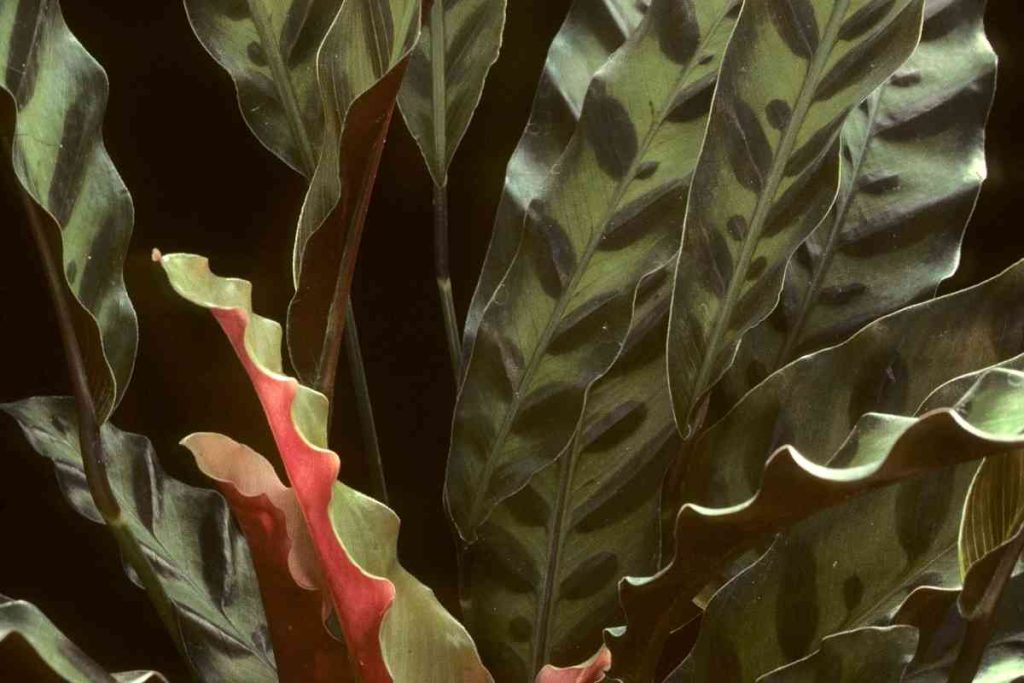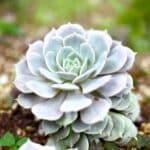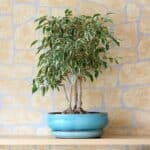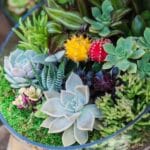Several plants are used for indoor decoration and landscaping. These plants helps to brighten lobbies, offices, conference rooms, and other interior surfaces, and they have various advantages.
Some offices and businesses prefer bright, colorful blooming plants, while others prefer a burst of green. However, one good thing about office plants is that they are reasonably easy to maintain and flourish in low-light environments.
The calathea Louisae is a plant you may wish to consider for your office or business property, regardless of your demands. Calathea plants thrive in low light, but some factors can make them difficult to grow.
Here’s everything you need to know about calathea Louisae care and growing tips:
Table of Contents
Calathea Louisae Origin: What is Calathea Louisae?
Calatheas are often known as prayer-plants, as are their relatives. Approximately 200 species previously classified as Calathea have been reclassified as Goeppertia.
Calathea has roughly 60 species at the moment. Many of the species are used as pot plants because of their decorative leaves and, in some cases, colorful inflorescences.
They are native to the tropical Americas. Young leaves and bracts can hold water pools called phytotelmata, which provide habitat for a variety of invertebrates
Calathea louisae) is a Goeppertia species endemic to Rio de Janeiro in southeast Brazil but cultivated in other parts of the world as an ornamental plant.
| Common Name | Cathedral plants, Peacock plants, and Rattlesnake plants |
| Botanical Name | Calathea |
| Plant Type | Ornamental plant |
| Family | Marantaceae |
| Sun Exposure | Calathea plants grow well in bright but not direct sunlight |
| Mature Size | Up to 80 cm tall |
| Soil type | Calatheas prefer a potting soil or mix that drains well |
| Leaf Color | The leaves of these plants have deep green and bright yellow stripe patterns on them |
| Native Area | Naturally grows in South American jungles |
| Temperature | Prayer plants thrive at temperatures ranging from 65 to 85 degrees Fahrenheit, but they prefer warmer temperatures |
| Toxicity | Safe for cats, dogs, and anything else (or anyone) who might come into contact with or eat your plants |
| Cool Hardiness | Temperatures below 55 degrees are too cold for them and can’t be tolerated |
Is Calathea Louisae an Indoor Plant?
It is a species of plant that enjoys indirect illumination, making it ideal for offices and other enclosed spaces.
Calathea plants are popular for interior use since they are often easy to maintain and look wonderful, providing brilliant green plants to brighten up small rooms.
Calathea Louisae Care and Growing Tips

Calathea plants are popular as indoor plants due to their ease of maintenance. They can be grown in a variety of containers and places.
As a result, they can be used in several settings. The following are some of the most important criteria for most Calathea species:
Calathea Louisae Light Requirements
Calathea plants thrive in bright but not direct light. This is because they grow on the forest and jungle floors, where they receive minimal light through the tops of the trees.
On the other hand, direct sunlight will scorch the leaves of a Calathea plant, causing it to lose its bright hues.
Calathea Louisae Humidity Temperature Needs
Calathea plants dislike being in the cold. They’re from the tropics and love temps between 65 and 80 degrees. Temperatures above and below can harm the plant, with the curling of the leaves being the first sign.
Calathea like humid environments because it is where they develop naturally. The large, green leaves that are typical of the plant may absorb moisture from the air.
Calathea Louisae Soil Requirements
Calathea Louisae thrives along the rainforest floor in its natural habitat, where the damp soil is fruitful with fallen leaves and other plant waste.
It’s ideal to use a rich, peaty mixture with adequate drainage when recreating this soil at home for your potted Plant.
Although Calathea Louisae demands a moist soil medium, this does not imply that you should use a heavy soil mixture that tends to retain too much water for an extended period since this might lead to rot.
You don’t want to use a fast-draining mix with too much sand, on the other hand, because you’ll have trouble keeping the soil moist.
Fertilizing Need
If you wish to fertilize your Calathea Louisae, do it largely between March and September while the plant is growing and flowering.
During this period, you may fertilize it every two weeks and every six weeks during the autumn and winter.
Use a basic houseplant fertilizer every four weeks during the spring and summer for optimal results. When plant development naturally slows, no fertilizer is required during the winter.
How to Propagate Calathea Louisae
Calatheas are best propagated by division during repotting time in the spring. You can easily divide the plant where it has produced its own natural separations in the roots when you remove it to repot it.
Because many calatheas have delicate roots, you should be as gentle as possible to avoid damaging the roots, which could affect the divisions’ growth.
Plant them in new container with fresh soil and keep them warm, wet, and humidified as much as possible. Reduce the amount of light until active development resumes, which should take two to four weeks.
Your Calathea should be repotted into a fresh potting mix every few years and divided again at that time.
How to Prune Calathea Louisae

If you have some leaves that are in poor condition, rather than attempting to save the majority of the leaf or simply ignoring the problem, you may be better off cutting the entire leaf off so that the plant can concentrate on developing new, healthy leaves.
If this is the case, don’t panic; it won’t harm your plant and will really make it look better in general. Looking at a plant with a lot of dead leaves is the worst.
Simply cut the leaf near the stem with a sharp knife or pair of scissors and discard the damaged leaf. Rather than trying to conserve dead leaves, your plant should focus on encouraging new leaf growth.
If the damage is minor, you may not need to remove complete leaves and instead only need to give your leaf a trim.
If your leaves are still intact, but the tips have been slightly crisped, you can just clip the tips instead of removing the leaf. Cut away the brown parts of the leaf with a pair of sharp scissors, keeping the majority of the leaves intact.
You’ll not only be helping the plant, but you’ll also be improving the appearance of your Calathea because let’s face it, no one likes staring at crispy tips.
Frequently Asked Questions
How do I keep Calathea Happy?
When the plant isn’t “praying” anymore, your Calathea plant isn’t happy. Calathea plants that are in good health should raise their leaves at night and reduce them during the day.
Calathea prefers moist, but not wet, soil. Mix 50 percent potting soil, 20% orchid bark, 20% charcoal, and 10% perlite in a container. They despise being dried out as well. Stick your finger in the soil every few days to test if it feels dry.
Where should I place my Calathea?
Calathea plants thrive in humid environments, appreciate indirect illumination, and thrive in gloomy environments. Plants should be kept away from any open windows that receive direct sunlight. Place a humidifier in the room or place the potted plants on a saucer packed with pebbles to create enough humidity.
Should I mist my Calathea?
Calathea plants are used to humid environments; therefore, if there isn’t enough moisture in the air, they can dry up and grow crispy leaves. Misting your calathea is an excellent approach to combat this. If you repeat this process often enough, it will begin to resemble the wetness present in a more humid environment.
How do you know if Calathea needs water?
These plants can be thirsty, but they also prefer a little dryness in their potting soil. As a result, inspecting the soil by hand every few days is ideal. It’s time to water once the potting mix has dried to a depth of 1 to 2 inches.
In terms of quantity, you’ll want to wet the soil completely. Do not, however, flood the soil. Ensure the potting soil drains well and that any extra water drains out the bottom of the pot.
When there isn’t enough aggregate in the soil, or there aren’t enough drainage holes in the pot, overwatering happens. It’s not because you overfilled the container with water. Root rot is caused by soil that does not drain well.
Does Calathea need grow lights?
Calatheas require at least 8 to 10 hours of bright indirect light per day to thrive. In order to give the same amount of daylight hours in the winter, you may need to use a grow light. However, if you’re growing a Calathea plant with artificial light, don’t give it more than 16 hours of light.
How do I know if my Calathea is dying?
You will know your calathea plants are dying if you notice that the leaves are turning yellow or brown or if the entire leaf turns brown or yellow with a wilted appearance.
How often should you water Calathea?
Calatheas benefit from weekly watering, which lets the top 2’ of soil partially dry out. To avoid overwatering and root damage in the winter, we recommend watering less regularly. This plant is not drought-resistant, and prolonged periods of drought will brown the leaf edges.
Should I cut yellow leaves off Calathea?
Some of the outer leaves will be yellow or brown as the plant matures and the leaves age. The appearance of your calathea plant can be improved by routinely removing yellowed or browned outer leaves.
Conclusion
The prayer plant will steal your heart with its illuminating green leaves and exquisite blossoms, despite the complexities of maintenance. With its brilliant hues and distinct overall appearance, this plant has the ability to revitalize any interior.
Calathea Louisae is also thought to bring happiness and well-being to the house, making it an excellent present for friends and family.
Every plant collector would be envious of your plant's beauty with the right care and attention. Imagine if there were more of them; what a lovely sight it would be!
Calathea is non-poisonous; thus, it can be planted everywhere. Of course, if your pets enjoy chewing on plants, exercise caution!
Related Posts:
- How to Save a Dying Calathea Plant
- Maranta Vs Calathea Plant
- Why Is Calathea White Fusion Leaves Curling?




